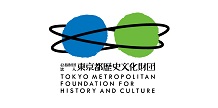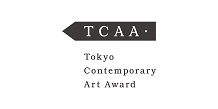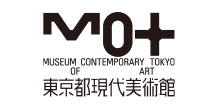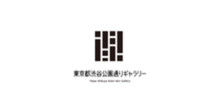MAEDA Kohei
- TOP >
- Archives >
- Residency Program >
- MAEDA Kohei
Local Creator Residency Program
update: 2023.10.12
MAEDA Kohei
| Participating Project | Local Creator Residency Program |
|---|---|
| Activity Based | Wakayama, Japan |
| City / Place stayed | Tokyo |
| Period | 2023.5 - 2023.7 |
Purpose of the residency
Starting from the TOKAS Residency, I will research the Sumida River to the Kanda River from the surrounding waters. During the high economic growth period, the Kanda River in the city center was once called the "river of death" because household and industrial wastewater flowed into the river. Currently, even sweetfish and salmon are making their way upstream. While superimposing my physical research and performance on the historical facts and existence of rivers in this city, I will discover the living thing called Tokyo.
Plan during the residency
- May 2023: Survey on the water area around TOKAS (Mainly the Sumida River to the Kanda River) and fieldwork
- June 2023: Fieldwork, production, and guest invitation
- July 2023: Fieldwork, planning/announcements of the archive exhibition, etc.
Activities during the residency
In the first half of my stay, I was interested in the canals around TOKAS (Tatekawa River, Oyoko River, Onagi River, etc.), and sought the way to enter them. In the second half, I practically entered around rivers by rowboat and conducted fieldwork. For my final performance, I traveled about 50km from the mouth of Edogawa River in Chiba Prefecture, passing through Arakawa River, Sumida River, and Kanda River, to Inokashira Park in Tokyo. On the way I went up the stream by rowboat, focusing on the environment and the historical background of the rivers, I overlapped my own experiences on the fact that they have been existing as various "roads".
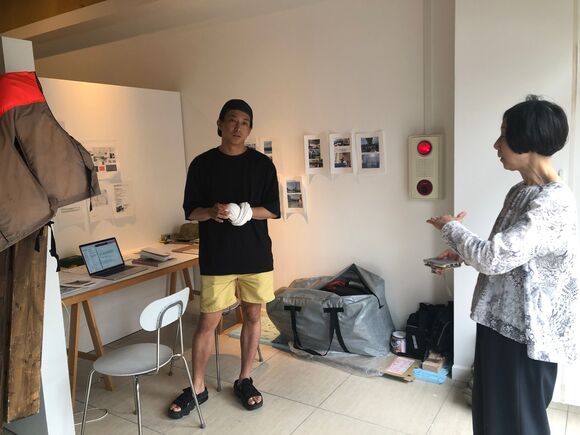
Studio visit
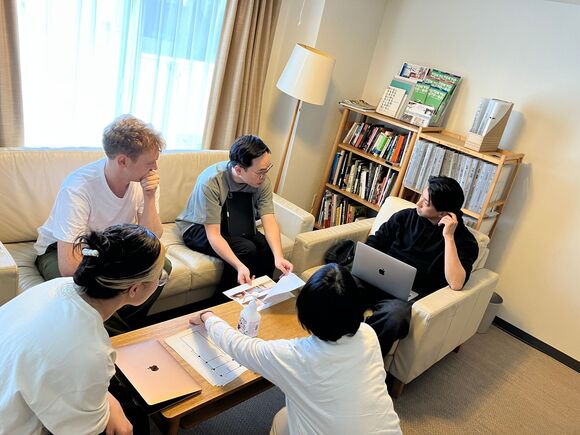
Meeting
Outcome of the residency
In this research, which I named "Tokyo Upstream," I had only a vague idea that I was going to travel up the rivers of Tokyo. Fortunately, I found many canals in the vicinity of TOKAS Residency, and Tatekawa river was right behind TOKAS, making it an ideal environment for my research. In order to go up the rivers in Tokyo, I had to do a lot of research on how to enter the rivers, routes, types of boats, moorings, passing through lock gates, etc. It was very difficult to determine how to pass through the river. I found that the raft I had brought with me was not suitable for the rivers of Tokyo, so I purchased a canoe, which was easy to carry. (If possible, I wanted to build a boat.)
In the second half of the residency, I decided to focus on the existence of a river as a "road" by canoeing and conducting various surveys while entering the rivers in Sumida-ku and Koto-ku. The first is the "tidal road". While in the river, I encountered a variety of aquatic life, and I also saw many creatures that live in saltwater areas, such as jellyfish, sea bass, and eels. Looking at them, I could feel the tides in the river. It means that sea life are invading the rivers inside Tokyo according to the tides. A man on a guard boat in the river told me that the gravitational pull of the moon creates five types of tides: spring tide, middle tide, neap tide, long tide, and wakashio(literally meaning in Japanese “young tide”), and that the current is especially fast and violent during the high tide of the spring. The tides are indispensable for upstream migration, and I realized that aquatic life regard the river as a path and are always riding or holding on to the current. I also learned from the biological survey conducted by Shinjuku-ku that ayu fish (sweet fish) are also moving upstream toward the rivers in the city of Tokyo.
The second is the "salt road”. It is now known that Kyu-Nakagawa River and Onagi River in Sumida-ku and Koto-ku were canals through which logistics headed in the direction of the city of Tokyo were carried out. During the Edo period, there were salt fields in Gyotoku area in Shimousa Province (in present Ichikawa city, Chiba Prefecture), and the Tokugawa family excavated the rivers around present Sumida-ku and Koto-ku in order to transport salt to Edo City. Initially, the route followed Funabori River (present Shinkawa River), which was a branch of Edogawa River, to Sumida River at Onagi River, which was opened up, and then went to Edo City. My research took me to the Tobacco and Salt Museum in Sumida-ku, where I learned that salt was a national monopoly and was the first resource and nourishment needed by humans.
I considered a river as a "road" and ultimately attempted to go up rivers. The route I took started at the mouth of Edogawa River in Gyotoku, Ichikawa City, Chiba Prefecture, where salt was actually produced during the Edo period (1603-1868) and where seawater enters the river. Passing through Sumida-ku, where TOKAS Residency is located, I aimed at Inokashira Park, the source of Kanda River (which also passes in front of TOKAS Hongo), which runs through the center of Tokyo.
Through the performance, I wondered what meaning the act of carrying seawater up the river could possibly have. There was a temple dedicated to the water at the Inokashira Park, and I thought that if the act of going upstream delivered seawater and sea salt to Inokashira, it could be said to have been a kind of pilgrimage road. I would like to continue my research on Inokashira Park, which can be regarded as a water source for the cities, and the worship of the water god, linking it to the existence of rivers in the city, for the exhibition at TOKAS Hongo next year.
Open studio
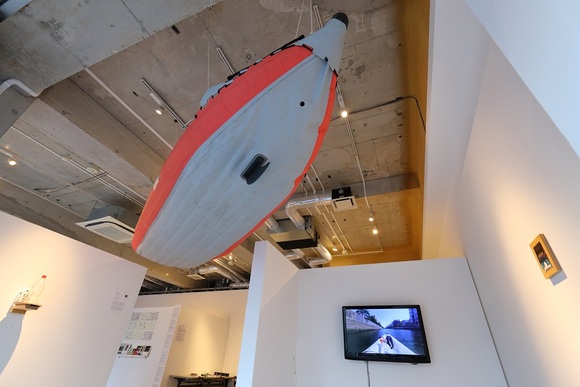
Open studio
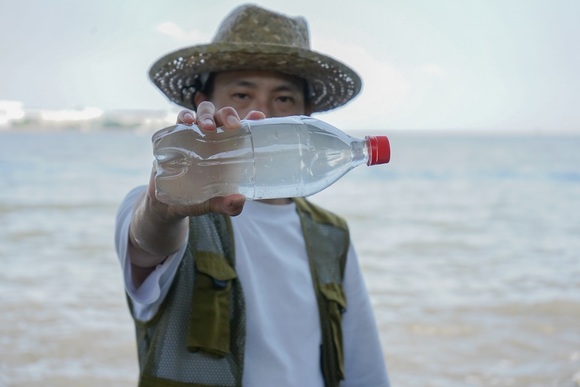
Performance
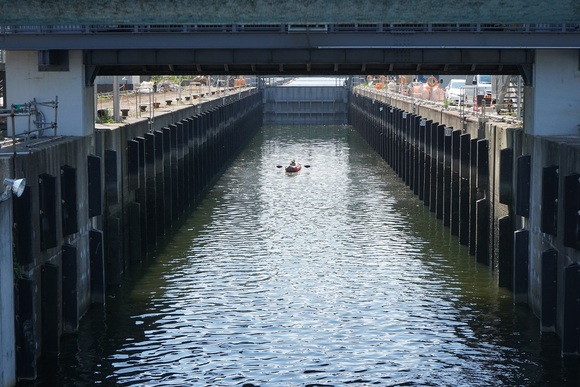
Performance
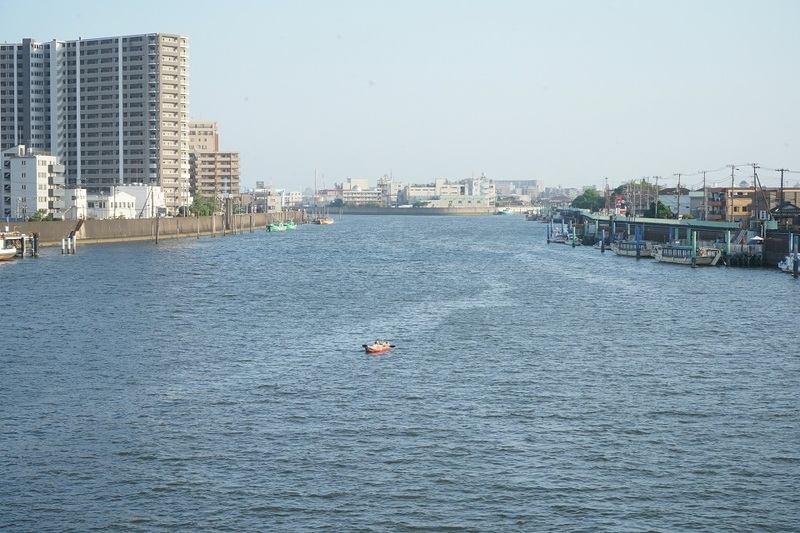
Performance




